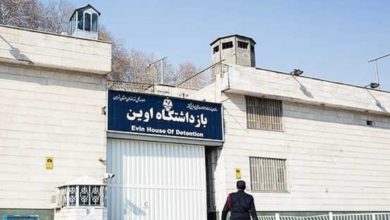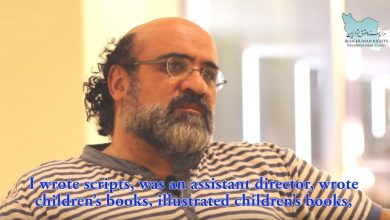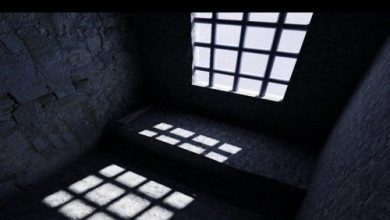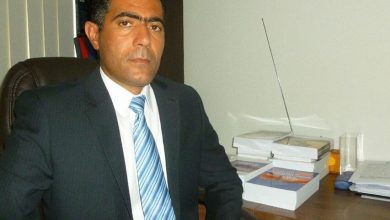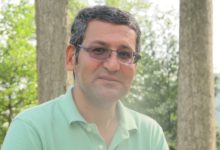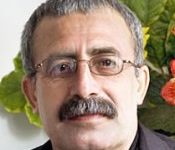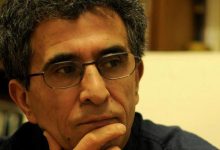Witness Statement: Hassan Zarezadeh Ardeshir
Hassan Zarezadeh Ardeshir is a human rights activist and journalist who has written extensively on human rights and politics in Iran. He was a spokesperson of the United Student Front and a co-founder of the Student Committee for Defense of Political Prisoners, a student human rights organization in Iran. In this witness statement, Ardeshir describes his multiple arrests by plain clothes agents affiliated with Iran’s Ministry of Intelligence, and the mistreatment he suffered in unlawful detention facilities.
Full Name: Hassan Zarezadeh Ardeshir
Date of Birth:
Place of Birth: Tehran, Iran
Occupation: Former Student; Journalist
Interviewing Organization: Iran Human Rights Documentation Center (IHRDC)
Date of Interview: February 15, 2008
Interviewer: Habib Rahiab
Witnesses: N/A
This statement was prepared pursuant to an in-person interview with Mr. Hassan Zarezadeh Ardeshir, a former student and journalist. The statement consists of 40 paragraphs and 9 pages. The interviews were conducted on February 15, 2008. The statement was approved by Mr. Zarezadeh on November 11, 2008.
Witness Statement
1. After the Chain Murders, the Ministry of Intelligence purged some intelligence officers who were implicated in the serial killings and transferred some of them to provinces other then Tehran. Some of those who were purged were recruited by the Islamic Revolutionary Guard Corps (IRGC) intelligence organization, although they were not big fish.
2. After the attack on Tehran University’s dormitory in 1999, the IRGC reached the conclusion that the Ministry of Intelligence was unable to suppress the dissidents. Therefore, the IRGC deployed troops to the university campus.
3. Pursuant to the raid on the dormitory, I was arrested and was called the greatest threat to the peace and security of the country. If you look at announcement No. 5, issued by the intelligence service, VAVAK, you will find that 90% of the announcement is about me. Although I was arrested by the Intelligence Ministry’s officers, the IRGC assisted and coordinated their operation with them.
4. In the second half of 1999, the conservatives had less leverage on the situation in Iran. Realizing the depth of the danger threatening them and losing control of the Ministry of Intelligence, the conservatives established the Parallel Intelligence Agency (PIA) with the approval of the Supreme Leader, Ayatollah Khamenei. The IRGC was the operational wing and the Judiciary was the legal wing of the PIA. The Law Enforcement Forces (or NAJA), however, did not have a big say in this newly established organization, even while helping them to arrest people.
5. In fact, NAJA got involved in the illegal activity of the PIA from the time the PIA needed secret locations for detaining dissidents. When the IRGC started to use Khatam base in Seoul Street and Amaken at the heart of the Tehran city as secret detention locations, NAJA got involved with the PIA.
6. Khatam is located in a residential compound where NAJA’s employees live. Part of this residential compound belongs to military officers who are responsible for conducting the military’s administrative issues. Khatam prison is located inside this administrative compound.
Surveillance and Arrest
7. When I was arrested on May 1, 2002, I was taken to Amaken office at first and then I was transferred to Khatam base.
8. Before being arrested I was suspicious that I was under surveillance. One day I received a call from my phone company and I was told to pay them a visit at their office as there was a technical problem with my phone service. I became suspicious when I got there and tried to find out a way to escape. I was on the 13th floor of a building in Karim Khan Zand Street. There was no way for me to escape. I took the elevator down to the first floor. The moment I went to get out of the elevator, I saw some people standing right in front of me. One of the men who was standing in front of the elevator commanded me not to move and said I was under arrest. I asked for a warrant but the man commanded me again to give myself up. I protested and said I would not because I did not know them. The man advised me and said it was good for me to hand myself over, otherwise I would be handcuffed. He said, “[C]ome on, Zareh! Give yourself up respectfully; otherwise you will pay a higher price.” Then one of the men showed me a weapon. I again asked for a warrant. The man replied that the warrant was inside the car and pointed out to a white Peykan car that was parked outside on the street. He also showed me his police ID card. When we got close to the car, I asked for the arrest warrant again. The man told me that he had forgotten the warrant. I inquired about my charges. The man said that someone had filed a complaint against me and charged me with fraud and robbery. I resisted getting into the car but they forced me to get in. The moment I was in, I was immediately blindfolded.
Detention
9. When I got out of the car, I saw Amaken’s name displayed on a board on a wall. I could see that because I was not properly blindfolded. At that moment, I realized that I would be imprisoned longer than I was imagining.
10. I was taken down to the basement and remained there for three to four hours. I was given a sandwich in Amaken. The name of the restaurant was on the paper wrapped around the sandwich. Amaken, however, was only a cover up for the Parallel Intelligence Agency. Amaken is a several story building and its basement was used by the PIA. I had already heard that a part of Amaken was being used to put pressure on political and cultural activists to stop them. Mr. Mohammad Ali Safari, a well-known lawyer and journalist, was one of those who was called to Amaken and questioned but died after a couple days because of the pressure interrogators put on him.
11. Three or four hours later, I was handed over to the PIA. The people had come from the Central Police Intelligence Service department, which was helping the PIA. The PIA handcuffed and blindfolded me and took me out to a Volkswagen car. The car did not go directly to its destination. It moved from one street to another and then another. The car was moving in circles. They wanted me to lose my sense of direction. Finally they took me to Khatam-ul Anbiyyah (henceforth I call it Khatam) prison.
12. Khatam was a very dangerous place. I was confined in a solitary cell; the threats started immediately and I was under huge stress all the time. They wanted to break me, demoralize me, and devoid me of my self-esteem. The guard at the prison greeted me with threatening words by saying “[H]ere we’ll skin you alive and silence you!”
13. After 20 days of solitary confinement, I was taken out for the first time to smell fresh air in Khatam. I noticed that Khatam was a big compound that had many huge trees. Then I realized why I was hearing birds singing in the morning.
14. Khatam is a secret prison located in a residential complex that belongs to the Iran Police Force, NAJA, on Seoul Street in north Tehran. The prison has 10 solitary cells on two sides of a narrow corridor that leads to the interrogation room, restroom and bathroom. The interrogation room is small with a table set right in front of the entrance door.
15. Actually I did not know the name of this prison was Khatam. When I got out of the prison, I did research to find out where I was held and found out that I was in a secret prison located in Khatam military base. Therefore, I call it Khatam prison.
16. Khatam was not made for political prisoners. It was made for smugglers and those who were charged with moral crimes. It was a very dangerous place. I saw prisoners tortured, beaten, and mistreated there. At least 10 people were beaten besides me. When I was in the cell, I heard people shouting because they were being tortured. I knew someone from my neighborhood that was beaten with an electric baton for two weeks to get him to confession.
17. I had heard that Mr. Pourzand was held in Police Intelligence Service detention, but nobody knew where. Some newspapers wrote that he was in Amaken because of his meeting with his sister, but actually he was not in the Amaken, it was just a cover place to confuse people. Amaken is a well-known place and usually is not used for security and political purposes. When I got to Khatam prison, I knew I was in the place that Mr. Pourzand was in, especially when a prisoner in the front cell told me he had seen Mr. Pourzand there.
18. I had heard before that Mr. Pourzand had disappeared and I knew that around 20 writers, intellectuals and journalists had been imprisoned in undisclosed locations. For instance, I knew that Mohammad Ali Safari, a well-known defense lawyer who defended many students after the attack on the university dormitory, (including me) was among those who were summoned by the PIA in Amaken. Mohammad Masoud Salamti, Hashmatullah Tabarzadi, Parviz Safari, and Siamak Pourzand were some well-known people who were summoned by the PIA. So when I got into Khatam prison I was trying to find other familiar people.
19. I saw two other people imprisoned in Khatam. One was an Afghan who was charged with having a sexual relationship with an Iranian girl and the second one was a man from Kermanshah. I call him Kermanshahi. He was charged with smuggling antiques. It was a very serious charge. Kermanshahi was a nice and very well-informed man about Iranian politics. He knew many Iranian writers and intellectuals (I know his name but because of security concerns I don’t want you to write his name). When I introduced myself, to my surprise he said he knew me. He had read about me in the newspaper and heard about me in radio interviews. We became friends and he told me about Pourzand and how he was mistreated in Khatam.
20. It was Kermanshahi who told me that Pourzand was in Khatam a week before I got there. He told me about how badly poor Pourzand was mistreated there. Kermanshahi said that Pourzand was severely mistreated in Khatam-ul Anbiya. The interrogators were insulting him, abusing him, and making him stand with his arms raised, facing the wall for hours and hours. He was weak and could not bear this pressure. His waist was aching and he was asking for mercy but the interrogators were pressuring him further and made him to stand even longer. He was interrogated for hours and hours and during interrogation, the authorities were insulting him. He was told that if he did not cooperate, they would blackmail him and threatened to charge him with sex offenses. He was made to sweep the prison. He was under huge pressure. He wanted to take his life and attempted to commit suicide. According to Karmanshahi, Pourzand was badly mistreated in Khatam. The interrogators, however, promised him if he cooperated he would be released.
Interrogations
21. I understand what he was saying as I was interrogated in a similar way. I had been arrested five times before and each time I was held in secret prisons like Prison 59 and mistreated in those locations for months. But none of those locations were as horrible as Khatam. I was held in Khatam for one month and in one month my hair turned gray. Khatam was the worst of all the secret prisons I have ever been in. The interrogators crush you until you believe you are not a human being anymore and not worth a penny.
22. Three investigators were interrogating me at one time. One of them was usually standing behind me, the second sat right in front of me, while the third one moved around the table and shouted, insulted and cursed me. They wanted to humiliate me, demoralize me, and destroy any shred of dignity I possessed. In a word, they wanted to “break” me. I was especially afraid of the man who stood behind me. I was afraid he would hit me at any time. He was a strong, fat man. He often shouted and intimidated me and told me if I didn’t confess, I would be severely tortured.
23. When I was taken into Khatam, my main interrogator, who was a fat and strong man and was respected by other guards, asked me if I knew where I was. I told him I was at a center that belonged to the police. He said I was wrong. He told me it was Towhid No. Two. Towhid was the name of a dangerous secret prison that Khatami’s government had shut down. He told me it was the “Second Towhid.” He wanted to scare me by implying that there was no rule of law here, no accountability; they were operating above the law and they could do anything. they wanted to me. They were not accountable to any authority. He told me that “[H]ere we will skin you alive.”
24. Khatam was unlike any other prisons I was in. Whenever I was taken outside my cell, I was blindfolded. Without being blindfolded, I was not allowed to step into the corridor. When I was taken for interrogation, I was blindfolded. When I wanted to use the restroom, I was blindfolded. I was not allowed to have any item with me inside the room. Even my blindfold was taken back from me every time I entered my room.
25. After some time in Khatam, I was made to watch how the investigators were beating other prisoners. The prisoners were miserably asking for mercy but they were still beating them. It was a very horrible scene. It was killing me. They were threatening me if I did not cooperate I would be tortured similarly.
26. On the first night I was taken for interrogation, the first question I was asked was why I had called other students to join the demonstration. I delayed answering, and then I refused to answer his question. The fat interrogator got up from his chair. When he got behind me, he punched me so hard that my head crashed into the wall. I was not expecting it. Everything turned dark for a while. I was not able to see anything. Then he told me that here was the place where I should talk. If I did not, I would be cut into pieces. Then he lifted me up in the air with his strong hands and wanted to throw me at the wall, but he didn’t. Two or three other investigators were watching us. They did not object. I was handed paper and instructed to write answers to questions about my group, my personal relations with the West and foreign groups, getting money from the West, and my political and social activities in the universities, newspapers, and political and social groups.
27. I did not write the expected answers and when I submitted my answer sheet, my interrogator commanded the others to handcuff me from behind. There were 4 of them. I got scared and pleaded with them not to but they did. It was painful but I was not suffering that much even though I pretended I was. My interrogator told me that this was just the beginning, to wait and see if I did not cooperate. Then he pressed me between his arms and I felt my ribs breaking. The handcuffs were also hurting me. I was complaining of the pain and after a few minutes they released me from the horrible handcuffs and pushed me to the wall.
28. And the interrogation started. I was beaten for two weeks. They did not beat me on the face and those body parts which were easily visible. They were beating my back and my head against the wall. When I compare the way I was beaten with other prisoners, I believe they treated me very kindly and gently. Other prisoners were beaten violently. Their heads were beaten against the wall; they were punched in the nose, kicked in the stomach, and lashed with whips made from tires and electric cables. When the detainees were sent back to their cells, blood was streaming down their heads and faces. I was not beaten like that but hearing them being beaten had a dreadful impact on me.
29.Using the restroom was also subject to cooperation. If a prisoner was not cooperating, he was not allowed to use the restroom more than 3 times a day.
30. I noticed in Khatam that the investigators were not familiar with the case at the beginning. They were compiling evidence from your own confession against you. They were making you implicate yourself in a crime. Based on your confession, they were making a case against you. For instance, my investigator did not know anything about me and the reasons I was arrested. He asked general questions. He did not know anything about me, but he was collecting evidence against me everyday from my own testimonies. He was coming up with new questions and new allegations after every interrogation session until he implicated me with some crimes.
31. After a few days, I was told if I cooperate I would be paid $50,000.00 US for each project. They wanted to bribe me. I was offered a good position and a house in Iran. The money had a condition. They wanted me to work for them, to justify their act and to spy for them but meanwhile I could be a critic of the government.
32. I did not accept their offer. After two weeks of torture and mistreatment, Judge Saberi Zafarqandi from Mehrabad Airport Court came to the prison to see my file. The PIA did not have an official document with which to arrest me and just got verbal permission on the phone. Actually, I was held in Khatam without any legal permit until Saberi came there. But when he saw me, he punched me from behind.
My Charges
33. I was charged for the first time there. They wanted to charge me with some offenses there. They wanted to justify my arrest retrospectively. After charging me with several crimes, such as acting against national security, I was asked if I accepted the charges. I told them I did not. I noticed the charge sheet did not have a date. They wanted to backdate the charge sheet and show that all things had been conducted legally. I protested and said I was not signing it. Judge Saberi Zafarqandi hit me on the back of the head and told me to sign and date the charge sheet for the day I was arrested. But I did not do that and left it blank. Saberi Zafarqandi had a close relationship with Judge Hasan Zareh Dehnavi.
34. Saberi Zafarqandi wanted to hand my case over to Qazi Haddad but Qazi Haddad refused to take my case. He said Saberi should legally decline from taking my case because he was the judge who had charged me with some offenses. Then I was taken to the Revolutionary Court, to Judge Haddad’s room at branch number 26. He said he was not aware of my arrest. Haddad told me that there was a legal problem with my case and I should go back to Khatam because Judge Saberi should sign the case over and express that his court is not qualified to consider it. I was taken to Khatam and after 3 days I was taken to Evin prison per Judge Haddad’s order. A day later, they took me to Haddad’s branch but this time I faced an interrogator from the PIA, who is a member of the IRGC. He said that he personally had recommended that I should not be badly mistreated in Khatam. He tried to say at first that they did not know anything about my arrest but the conversation between us showed me that the Police Intelligence Service detention was a cover and they were behind everything. Actually, I was taken to Khatam prison because I had already been kept for five months in Prison 59, which belongs to the IRGC, and 3 months in Towhid. I knew all the techniques used there for extracting confession so I was sent to a worse place this time.
35. Prison 59 was an old prison administered by the IRGC, specifically by the IRGC’s Intelligence Protection office. Prison 59 was originally made for military prisoners but the conservatives were using it to extract information from political dissidents. When the Parallel Intelligence Agency was established, Prison 59 was used by them.
36. In early 2000, the PIA arrested Azatullah Sahabi and Ali Afshari of the Melli- Mazhabi coalition. Then three colleagues of mine, Koroush Sehati, Hamid Reza Mobayyen, and Saeid Kashiloo, were arrested from the United Students Front. In late 2000, near Norooz, the PIA targeted national religious leaders, also a part of the Melli-Mazhabi coalition. Then they attacked the University’s dorms and we were arrested. The PIA targeted two very important dissident groups, students and political activists, and established many secret prisons. Reformists tried to expose the existence of the secret prisons. Finally Majlis, which was controlled by the reformists, established a commission under the auspices of Mr. Ali Akbar Musavi-Khu’ini to investigate the existence of secret prisons. The commission found that many illegal prisons were operating in Tehran. One of these prisons was Towhid, which was closed down at that time. The IRGC moved its prisoners from Prison 59 to a block in Evin. The State Prison Organization did not have the authority to monitor this block in Evin prison. For instance, three or four years ago (in 2002 or 2003) IRGC did not grant permission to Abbas Ali Alizadah, the General Prosecutor of Tehran who had a mandate from the Judiciary to visit all the prisons in Tehran, to visit this block of Evin prison which was controlled by the IRGC.
37. Prison 59 was located in Eshratabad, which is an old military base. The prison had a long corridor that was connected to another, forming a T-shape. On each side of the corridor there were 8 cells. However, the cells on the right side of the corridor were smaller than the left. Room # 1 on the left side, which was larger in size, was called the “confession room.” At one end of the corridor were the investigators rooms and on the other side of it were restrooms, bathrooms and a barber room.
38. I was in Prison 59 for five months and a few days, from June 2001 to November 2001. Investigators were trying to convince us that Prison 59 belonged to the Judiciary but we knew it did not.
39. Early in the morning, the military trained at Prison 59. We could hear their voices and the sound of military marching. Instructions were usually given using a loudspeaker and we could hear them. I was interrogated in two rooms and my investigators were an officer from IRGC while I was in Prison 59. After Prison 59 was closed, Khatam was opened and it could be open now. Khatam did not have a doctor but Prison 59 did.
40. Khatam was the worst of all the prisons I’ve ever been in. I was in Prison 59 for 5 months, but the month I was in Khatam was a hundred times worse then the five months I was in Prison 59. In one month my hair turned gray in Khatam. I was broken there.

